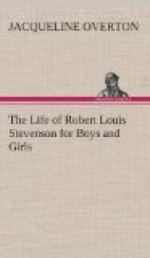“No stranger hand touched him.... Those who loved him carried him to his last home; even the coffin was the work of an old friend. The grave was dug by his own men.”
Tusitala had left them, and his friends in the South Seas had lost a faithful friend and companion, a wise and just master.
His family and friends the world over had lost not only these but far more. His life had been a chivalrous one with all the best that chivalry stands for, “loyalty, honesty, generosity, courage, courtesy, and self-devotion; to impute no unworthy motives and to bear no grudges; to bear misfortune with cheerfulness and without a murmur; to strike hard for the right and to take no mean advantage; to be gentle to women and kind to all that are weak; to be rigorous with oneself and very lenient to others—these ... were the traits that distinguished Stevenson.”
“They do not make life easy as he frequently found.”
His resting-place on the crest of Vaea Mountain is covered by a tomb of gray stone. On one side is inscribed in English the verses he had written for his own requiem:
A ROBERT LOUIS [Symbol: Omega] 1850 STEVENSON 1894
“Under the wide and
starry sky,
Dig the grave and let
me lie,
Glad did I live and
gladly die,
And I laid me down with
a will.
“This be the verse you
grave for me:
Here he lies where he
longed to be;
Home is the sailor,
home from the sea,
And the hunter home
from the hill.”
[Illustration: The tomb of Stevenson on Vaea Mountain]
On the other side, written in Samoan and surrounded by carvings of thistles, his native flowers, and the hibiscus flowers, emblem of the South, are the words from the Bible:
“Whither thou goest I will go, and
where thou lodgest I will lodge;
thy people shall be my people; and thy
God my God; where thou diest
will I die, and there will I be buried.”
The Samoan chiefs have forbidden the use of firearms upon Vaea hillside, “that the birds may live there undisturbed, and raise above his grave the songs he loved so well.”
“Tusitala, the lover of children, the teller of tales,
Giver of counsels and dreams, a wonder, a world’s delight,
Looks o’er the labours of men in the plain and the hills; and the sails
Pass and repass on the sea that he loved, in the day and the night.”
—ANDREW LANG.
BIBLIOGRAPHY
SOME WORKS IN RELATION TO STEVENSON’S LIFE, WRITTEN BY HIMSELF AND OTHERS
GENERAL BIOGRAPHY
Balfour, Graham: “Life of Robert Louis Stevenson.” Two vols.
Colvin, Sidney, ed.: “Letters of Robert Louis Stevenson,” with biographical notes and an introduction by the editor.




